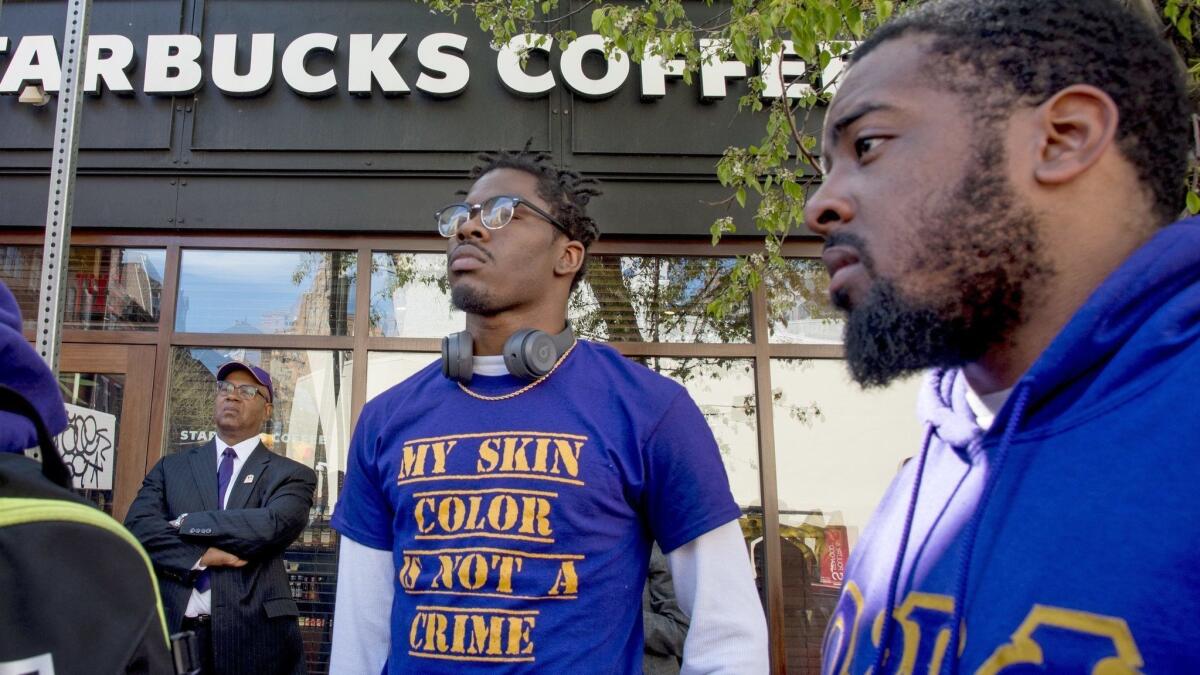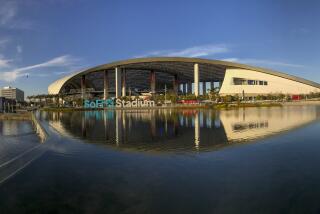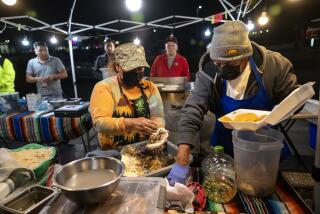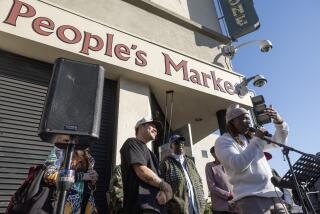Op-Ed: Black people were lulled into thinking Starbucks was different — a safe space. We were wrong

Starbucks is synonymous with the urban good life, an oasis where anyone with a few dollars can get a caramel macchiato and sit for hours writing, reading, talking or contemplating life. It’s cookie-cutter, but that’s the point — its thousands of stores powerfully symbolize the luxury of leisure time, and a culture of aspiration. That’s why after the L.A. riots, South Central put Starbucks on its wish list for what should replace burned-out storefronts and unsavory businesses like liquor stores. In Ladera and Compton, just as in Larchmont and Hermosa Beach, Starbucks guarantees dreaming space, a purely “me” space for all of us city dwellers.
When two black men arrived at a Starbucks in Philadelphia a week and a half ago, that’s what they were apparently thinking too: We all belong to the Starbucks nation. But in the days since those men were arrested for trespassing, we’ve been grappling with the jarring reality that for black people, especially men, there is no such thing as that kind of neutral space; at least it’s not guaranteed.
Rashon Nelson and Donte Robinson were denied access to the Starbucks restroom because they hadn’t purchased anything, so they sat down to wait for a (white) friend they’d arranged to meet there. An employee called the police; officers arrived minutes later and quickly arrested the two of them.
It’s notable that Nelson and Robinson were dressed nattily, like hipsters — that is, they looked like typical Starbucks clientele, they didn’t present as homeless or gangsta, two conditions closely associated with black men that put retailers on edge. When the police showed up, Robinson, who acknowledges that he harbors the usual black-man wariness of law enforcement, said he nonetheless believed the officers who showed up minutes later “couldn’t have possibly come for us.” This is what black people get for thinking they blend in, for not remembering that their assumed invisibility can change in an instant.
Anonymity, like leisure time, can be a luxury we aren’t always afforded.
That things took a nasty turn in Philly isn’t merely an artifact of back-East intolerance. Earlier this year at a Starbucks in Torrance a black man who was also denied access to the restroom videoed a white customer who was given access with no problem. (The denial of bathroom use in both cases is an uncomfortable reminder of the segregated toilets common in the South during Jim Crow. So much for aspiration.)
I admit, I have been lulled into believing that Starbucks is a safe space, too. I’ve camped out with a computer or a book along with others who may stay a half hour or half a day. I haven’t run into resistance, and I’ve committed the sin of forgetting how tenuous safety can be.
Lingering anywhere can be seen as ominous. Black people aren’t “waiting,” we’re “loitering,” an infraction that goes back to post-Reconstruction days when police were looking to contain blacks who’d migrated north from the Jim Crow South. The racial double standard around leisure time has become embedded in our culture. Young white men not gainfully employed are sometimes called, almost affectionately, slackers or creatives; young black men not employed — let alone standing around — are potential criminals.
And anonymity, like leisure time, can be a luxury we aren’t always afforded. I’ve relaxed in Starbucks because I do feel anonymous there. I fancy myself just another person ordering a flat white. We all speak Starbuck-ese, right? Tall, grande, extra shot of this or that. And my order, not my skin color, is the most notable thing about me. I feel the same way at Trader Joe’s all over town, when I’m hunting down ginger granola and dark chocolate-covered acai berries. I don’t think I stand out, which is why I’ve always called TJ’s the happiest place on Earth, happier than Disneyland.
The Philadelphia incident has disrupted all that, brought me back to the unwelcome fact that blacks are still not equals in the culture of aspiration that Starbucks, in its modest way, represents. In the minds of a crucial few, Nelson and Robinson were not in a typical meeting place to discuss business, they were wannabes, they didn’t fit, and they had to be called out. What the Starbucks employee and the cops thought the two men were doing, and who they were, was more important than the truth.
Starbucks’ management is responding to the Philadelphia incident with a vengeance. The employee who called the police is gone, though exactly how or where isn’t completely clear. (Fired? Moved? Witness protection?) And there have been clear and unadulterated mea culpas. Chief executive Kevin Johnson apologized personally to Nelson and Robinson, a move in keeping with the company’s racial-awareness campaign “Race Together,” which was rolled out (and short-lived) in 2015. On May 29, most of Starbucks’ 8,000 locations will close down for a day of racial-bias training.
The company wants to protect its profits, I’m sure, by winning back any customers put off by the racism that seems antithetical to the Starbucks brand of better living through lattes. I’d also like to believe that it really does understand that what happened was wrong, and is making amends. I can dream — though I’m half avoiding Starbucks now — can’t I?
Erin Aubry Kaplan is a contributing writer to Opinion.
Follow the Opinion section on Twitter @latimesopinionand Facebook
More to Read
A cure for the common opinion
Get thought-provoking perspectives with our weekly newsletter.
You may occasionally receive promotional content from the Los Angeles Times.






